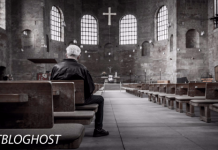Gene Autry’s rendition of “Rudolph the Red-Nosed Reindeer” was a hot item when it was released for the Christmas season in 1949. One of my aunts bought me a “45” record of it, and I played it so much my parents threatened to throw it away. By now I have long gotten tired of hearing it. But I have engaged in a bit of theological reflection on the Rudolph message.
Rudolph “came unto his own and his own received him not.” He was “despised and rejected” by his peers. In a dramatic turnaround, however, he came to be seen by those who had mocked him as the only one who could provide the light that would guide them on their journey.
Stretching it a bit theologically? Of course. But we would do well to think about the ways in which the narratives of the non-Christian icons of our major Holy Days do in some sense mirror elements of the Gospel story. Santa and the Easter Bunny are obvious cases in point. Santa descends from above bearing gifts—although he also has been known to issue a word of judgment on the naughty ones. The Easter Bunny comes up out of the ground bearing eggs—the vessels of new life. Instead of simply condemning Santa and the Bunny, we might see them as symbols of deep human yearnings that find their only genuine fulfillment in the real events that we celebrate on Christmas and Easter.
I think I understand some of the Rudolph story’s appeal to kids. It is not unlike the Ugly Duckling tale. The rejected one—the object of ridicule—is transformed into the hero whom everyone admires. Any kid who has spent any time on a school playground has hoped for that kind of thing to happen in his or her life.
There is one issue about Rudolph, however, that I have never heard anyone else raise, so I will name it here. How could that glowing red nose provide enough illumination to guide a team of reindeer on a foggy night? The truth is that Rudolph was not really capable of lighting the way.
Nor is Santa capable of bringing the gifts that truly satisfy us. Nor can the Easter Bunny deliver on the promise of bringing new life out of the deep places.
Not that these non-Christian icons deserve simply to be condemned. Maybe it’s time to treat them as conversation starters for the telling of story about the One who alone is the true Light—the One whose birth in Bethlehem was indeed “the dawn of redeeming grace.”
5 Comments »
-
There is one issue about Rudolph, however, that I have never heard anyone else raise, so I will name it here. How could that glowing red nose provide enough illumination to guide a team of reindeer on a foggy night? The truth is that Rudolph was not really capable of lighting the way.
Indeed, any good driver can tell you that, if you’re driving through a fog, the last thing you want to do is turn on your brights!
Comment by Mark Baker-Wright — December 13, 2007 @ 5:48 pm
-
Thanks for the nice reflections. When I was child (I was born in ‘62), we were still watching the Rudolph TV special (built around the song) every year around Christmas. (I think they may still show it now, but I don’t know, and, what with all the cable TV options available to kids — their Nickelodeon, etc. — I don’t know if it gets widely watched even if it is shown.)
Some might be interested in related theological musings on the Rudolph story over at Richard Beck’s blog at:
http://experimentaltheology.blogspot.com/2007/12/everything-i-learned-about-christmas-i.htmlComment by Keith DeRose — December 14, 2007 @ 1:02 pm
-
I like the idea of stretching the Rudolph tale theologically. It makes one wonder about all sorts of tales and stories we know, hear and read. What are the many lessons to be learned within each tradition we see, hear, participate and reflect upon this season? How do those cause us to take the light of Christ to the world? (Or not). The great part of Rudolph, the Bunny, and Santa is this: sometimes in the childlike mind there has to be something tangible that can represent the sometimes very intangible gifts of the hope, love and the Spirit of Christmas. To me the Easter Bunny, Santa and Rudolph help to represents the good aspects of faith that small children may not have the fullest capacity to grasp and comprehend. And because there is always the flip side of the good that exists, these tales and traditions have their flip sides too. So…until the children can understand the shades of human behavior, and the mystery of the Spirit we can represent these great events of the Christian faith–and holiday traditions through the Bunny, Santa, and Rudolph….after all they remind us to once again approach our own faith understandings as that of a child. After all, once you see a deer or elk in a snow covered forest, you realize–the nose with a light, well it was all just to help you believe in the eternal light within! Since we still expect and maintain a faith that has the light from the One Christ showing the way, I would venture to say it is safe to keep stretching the kids cartoons theologically…after all isn’t that what theologians do?
Comment by Nancy Bird — December 17, 2007 @ 6:36 pm
-
For me, “Rudolph the Red Nosed Reindeer” is an enchanting Christmas song. Wonderful to think that a young reindeer would take the risk to lead the way for his older friends with his little lighted red nose.
Christ is the only true Light. I had a prison correspondence and telephone ministry years back for death row inmates in Oklahoma and Texas named “The Light of Christ.”
I respect the late Gene Autry, who was a good man. He had deep family ties to Oklahoma as well as Texas. So do I.
God bless and Merry Christmas.
Sunny Murchison
SOT Recovery MinistryComment by Sunny Murchison — December 18, 2007 @ 3:50 pm
-
This isn’t so much about Rudolf as nostalgia. I was just here talking with my husband, Ken Wissoker, about my great education at Elmhurst College and mentioned you. We went to wikipedia to find out where you were and then to this blog and I decided to write. May you and yours have a happy holiday—and I hope it pleases you to know that your pre-doctoratate lectures are still remembered by at least one of your former students.
Best wishes,
Cathy Davidson
Comment by Cathy Davidson — December 22, 2007 @ 12:57 pm






























